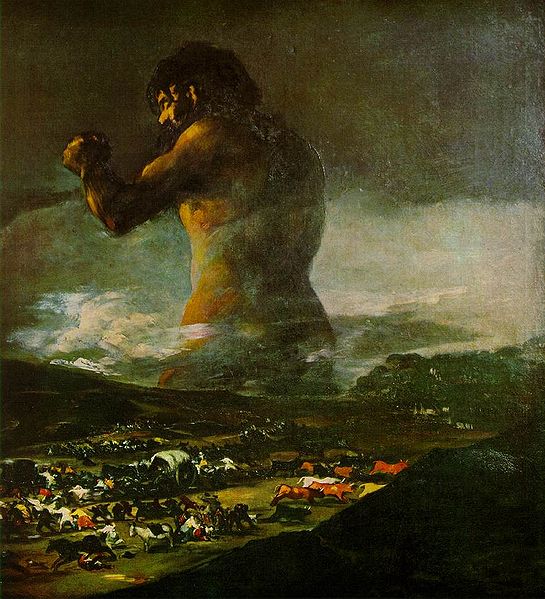Francisco Goya: A Life by Evan S Connell
Read: May-June, 2007
Goya is probably my favorite artist of all time, for two principle reasons. First, he is of Basque origin. In fact, his ancestors (either his grandfather or his great-grandfather) was from the town of Zerain, Gipuzkoa. My mom’s grandfather, Blas Telleria, was from Mutiloa, Gipuzkoa, which is right next door. In doing some research on my genealogy, I found that one of my ancestors was named Blas de Goya, also from Mutiloa. Thus, it seems to me that there is a small chance that Goya and I are “cousins”. Which I find sort of cool.
 The second reason I like Goya is because I just plain like his art. Most of it I don’t appreciate much at all. It seems that half of art can only be appreciated in context. In the case of Goya, his paintings of the Spanish royal family, for example, seem to be lauded because he didn’t idealize his subjects and that was radical for his time. For me, it doesn’t seem all that exciting and I don’t really find all that much of interest in those paintings. However, his Black Paintings and many of his etchings are just plain fascinating. I was lucky enough to find a used copy of his complete etchings at Powell’s in Portland. Especially those dealing with the Spanish war with Napoleon I find very interesting. Goya depictions of humanity’s dark side are, in my mind, still unparalleled.
The second reason I like Goya is because I just plain like his art. Most of it I don’t appreciate much at all. It seems that half of art can only be appreciated in context. In the case of Goya, his paintings of the Spanish royal family, for example, seem to be lauded because he didn’t idealize his subjects and that was radical for his time. For me, it doesn’t seem all that exciting and I don’t really find all that much of interest in those paintings. However, his Black Paintings and many of his etchings are just plain fascinating. I was lucky enough to find a used copy of his complete etchings at Powell’s in Portland. Especially those dealing with the Spanish war with Napoleon I find very interesting. Goya depictions of humanity’s dark side are, in my mind, still unparalleled.
Some of my favorite paintings by Goya include Saturn Eating his Son, the Third of May, and The Colossus.
I just finished reading Evan Connell’s biography of Goya, entitled, simply, Francisco Goya: A Life. Rather than get into all of the minute details of Goya’s life, Connell rather puts Goya’s life into the context of Spanish society of the time. That is, we get to know Goya as much through his interactions with Spanish royalty as through his own deeds. Connell goes on a number of tangents dealing with important Spaniards of the time and their goings on. We learn a lot about the sexual conduct of certain powerful women of the time, partially because these women, including the Queen of Spain, determined so much in the life of people like Goya. I think part of the reason these women feature so prominently, though, is because of the titillation factor.
the context of Spanish society of the time. That is, we get to know Goya as much through his interactions with Spanish royalty as through his own deeds. Connell goes on a number of tangents dealing with important Spaniards of the time and their goings on. We learn a lot about the sexual conduct of certain powerful women of the time, partially because these women, including the Queen of Spain, determined so much in the life of people like Goya. I think part of the reason these women feature so prominently, though, is because of the titillation factor.
Connell’s style is very familiar. At first, this was a bit off-putting; it was almost too familiar. But after a while, I became accustomed to his style and actually really enjoyed it. Sometimes, the style makes it hard to follow what Connell is talking about. He uses very colloquial phrases and terms and writes as if he is talking with the reader rather than writing an authoritative biography on his subject.
 This is the first book specifically on Goya I have read and it may be that part of the reason that Connell digresses on so many other people is because there just isn’t that much known about Goya himself. I just don’t know. For whatever reason, because of this style, we learn a bit less about Goya the man and a good deal about the Spain in which he resided, the Spain that shaped him and his art. We learn about the foibles of the nobility, the misery of the peasants, and the horrors of war. Thus, as a book on Goya, it maybe leaves a little to be desired. But, as both an account of Spain in the later 1700s and as an entertaining romp through history in its own right, this is an excellent book. I highly recommend it to any Spanish history buff.
This is the first book specifically on Goya I have read and it may be that part of the reason that Connell digresses on so many other people is because there just isn’t that much known about Goya himself. I just don’t know. For whatever reason, because of this style, we learn a bit less about Goya the man and a good deal about the Spain in which he resided, the Spain that shaped him and his art. We learn about the foibles of the nobility, the misery of the peasants, and the horrors of war. Thus, as a book on Goya, it maybe leaves a little to be desired. But, as both an account of Spain in the later 1700s and as an entertaining romp through history in its own right, this is an excellent book. I highly recommend it to any Spanish history buff.
 I’m a big beer fan. While I really don’t like any hard liquors and am only luke warm to most wine (unless it is used with coke to make
I’m a big beer fan. While I really don’t like any hard liquors and am only luke warm to most wine (unless it is used with coke to make  The lauburu, literally “four heads” in Basque, is a ubiquitous and ancient Basque symbol. You see it all over the place in the Basque Country and has become a national identifying symbol. It has obvious connections to other four-armed symbols, such as the swastika, a symbol that appears in many parts of the world, including India and North America.
The lauburu, literally “four heads” in Basque, is a ubiquitous and ancient Basque symbol. You see it all over the place in the Basque Country and has become a national identifying symbol. It has obvious connections to other four-armed symbols, such as the swastika, a symbol that appears in many parts of the world, including India and North America.